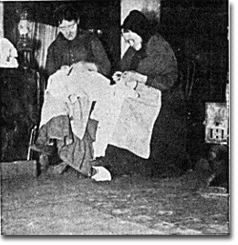38b. The Underside of Urban Life

Lights, trolleys, skyscrapers, romance, action. These were among the first words to enter the minds of Americans when contemplating the new urban lifestyle. While American cities allowed many middle- and upper-class Americans to live a glamorous lifestyle, this was simply a fantasy to many poorer urban dwellers. Slums, crime, overcrowding, pollution, disease. These words more accurately described daily realities for millions of urban Americans.
Tenements
Much of the urban poor, including a majority of incoming immigrants, lived in tenement housing. If the skyscraper was the jewel of the American city, the tenement was its boil. In 1878, a publication offered $500 to the architect who could provide the best design for mass-housing. James E. Ware won the contest with his plan for a dumbbell tenement. This structure was thinner in the center than on its extremes to allow light to enter the building, no matter how tightly packed the tenements may be. Unfortunately, these "vents" were often filled with garbage. The air that managed to penetrate also allowed a fire to spread from one tenement to the next more easily.
Because of the massive overcrowding, disease was widespread. Cholera and yellow-fever epidemics swept through the slums on a regular basis. Tuberculosis was a huge killer. Infants suffered the most. Almost 25% of babies born in late-19th century cities died before reaching the age of one.
The Stench of Waste, the Stench of Crime
The cities stank. The air stank, the rivers stank, the people stank. Although public sewers were improving, disposing of human waste was increasingly a problem. People used private cesspools, which overflowed with a long, hard rain. Old sewage pipes dumped the waste directly into the rivers or bays. These rivers were often the very same used as water sources.
Trash collection had not yet been systemized. Trash was dumped in the streets or in the waterways. Better sewers, water purification, and trash removal were some of the most pressing problems for city leadership. As the 20th century dawned, many improvements were made, but the cities were far from sanitary.
Poverty often breeds crime. Desperate people will often resort to theft or violence to put food on the family table when the factory wages would not suffice. Youths who dreaded a life of monotonous factory work and pauperism sometimes roamed the streets in gangs. Vices such as gambling, prostitution, and alcoholism were widespread. Gambling rendered the hope of getting rich quick. Prostitution provided additional income. Alcoholism furnished a false means of escape. City police forces were often understaffed and underpaid, so those with wealth could buy a better slice of justice.
The glamour of American cities was real indeed. As real was the sheer destitution of its slums. Both worlds — plenty and poverty — existed side by side. As the 20th century began, the plight of the urban poor was heard by more and more reformers, and meaningful change finally arrived.






